|
Having trouble viewing this email? View it as a Web page. | 
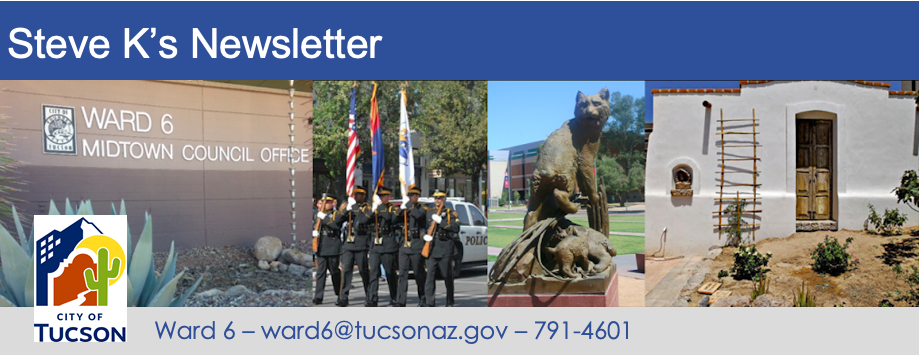 Date: 03/29/2022
Topics in This Issue:
Humanizing the Homeless
You can see John seated on a bench over in the underbrush. He preferred that I not take his picture directly. John is a 40-year-old guy who was born in Denver. He only finished the 7th grade but did earn a GED. John was in a pretty mentally depressed state when he and I shared some time together. Both of his parents had died from COVID within days of one another. John has been homeless since having to fund both funeral expenses at pretty much the same time. He has been on the street for 2 weeks, but says it feels like forever.
It's important to note here the obvious; that is, I'm telling you the stories these people share with me. I'm not 'fact-checking' or cross examining anybody to try to prove or validate the accuracy of the story. What they share is reflective of their current state of mind - it might be fully accurate and truthful, or it might be varnished to hide some hurt they're living with. I got the sense that John might be shading some of the truth, but it was clear the longer we spoke that he is a bit of a broken spirit.
When I asked what made him happy, John said 'not a lot.' He eats by panhandling, washing car windows and asking for money at intersections. What makes him sad is the way people look at him and how they react to people in his situation. His message is that this could happen to anyone and for others to show some compassion and not dismiss the homeless as worthless. He said a few times that he didn't ask to be in this situation, and that he's 'human too.'
I’m going to introduce you to two guys this week for a couple of reasons. One is that John was a bit reticent – which is fine, and which is his perfect right. The other reason is that he has some commonalities with this next guy. From standing and spending time talking with John it was clear he is wrestling with some inner issues. I won’t try to play lay-doctor and analyze that – could be drug related, mental health, depression or a combination. But that’s also true of Albert.

Both John and Albert are perfectly friendly guys, and both wanted to share their stories. We’ve known Albert for a while. He used to have his tent pitched at the east end of the W6 office. I’d go out daily and chat with him, letting him know he was fine being there as long as things stayed controlled. Over time that became less and less the case, and it was clear he could use some assistance. I contacted our TPD Homeless Outreach Team (HOT) and they took Albert to the Crisis Response Center. An assessment was done, and he was released back to the street. Albert is an example of many of the homeless who simply do not want and would not thrive in a shelter setting.
Some of the homeless people we'll encounter have some cognitive issues they're dealing with. And yet, they're still people struggling to make things work under difficult conditions. Albert is one example.
Albert just turned 65. He was born in Tucson but has travelled around over time. He finished High School and has had a couple of years of college. Albert also joined and served in the Air National Guard.
Albert has travelled with a brother, sister and his mom - on and off. He's alone now. His dad died in 1987, and shortly after that his family split apart. Albert has been roughly 26 years total in and out of jail since that time. He was last released from prison in North Carolina, and he came to Tucson from there. Sort of a coming home for Albert.
One of Albert's challenges is losing a train of thought, and getting agitated when recalling incidents, he has had with the law. One example is police 'going through personal property' when being booked. When he's not in that confused and agitated state, Albert is an affable and friendly guy. He loves the outdoors, doesn't want to live in a shelter. His message to others is simply 'don't give up, no matter how much you have.'
Albert and people like him can benefit from some of the social services the city invests in. The trouble is, he doesn't recognize that. At the CRC he displayed no threat to himself or others. He was released.
That's the cycle he and others in his situation endure. We cannot compel treatment, and they don't quite recognize its benefits.
|
Quick note – on April 5th the city council will resume meeting in person. The public is invited. Masks are optional/recommended. I’ll have more on the COVID situation below. We’re nearly 2 years to the day from having gone to virtual meetings. We are taking reservations for meetings in our two meeting rooms. Contact us at ward6@tucsonaz.gov to begin that process – or stop into the office between 9am and noon and we’ll get you signed up. For now,the large community room continues to be where we’re accepting and distributing donations for refugee families.
Pima Animal Care Center
They’ve got a relatively new director out at PACC. Monica Dangler is in the saddle now and has kept PACC headed in the positive direction they’ve been going for the past several years. One of the challenges they face is a severe staffing shortage. The response times on calls is days, unless the call is one of their priority emergencies. Those include police assists, an animal having been hit by a car, sick/injured, bites and rabies exposures.
If you have an aggressive dog in your neighborhood, it’s important that you call and report it. The call goes to 520.724.5900, x4. Unless the call is for one of the listed emergency priorities, PACC will send a letter to the homeowner advising of a complaint. That’s for barking dogs, or for other non-emergency situations. In order for them to build a case, they need to hear from you. Please be sure when you call to give a very clear description of the nature and severity of the situation. Their goal is to provide prompt service and prioritize the most dangerous calls first, so giving them accurate information will help them properly allocate their limited resources.
PACC is also adopting-out dogs and cats daily. As the end of the UA semester nears, they’ve got to make room. Every year when students pack up and leave, one of the ‘non-essentials’ appears to be their furry family members. PACC becomes overwhelmed, so now is a great time to head out and look for your new roommate. PACC is located at 4000 N. Silverbell Rd. They’re open Monday through Friday from noon until 7pm, and on weekends from 10am until 5pm.
Afghan Refugees
I’m opening this week with a big thanks to volunteers Debbie from Sam Hughes neighborhood and Mark from our own office team. Together they got our donation room organized and worked to get the clothing distributed to agencies who’ll connect it with those in need. For the Afghan families we are only taking donations of kitchen goods, rugs, laptops and sewing machines. Thank you all who have continued to step towards these ongoing needs. The Afghan families are still largely being housed in hotel space. Many became frustrated with the housing situation in Tucson and have relocated to Sacramento. I’m not so sure California is a better option, but they’ve made that choice. We’ll keep doing what we can to help the Afghani’s who are still in Tucson get settled and welcomed.
Saturday my bride and I joined several hundred members of the Afghan community over at the Reid Park Bandshell. It was great to see many familiar faces. They were celebrating Nowruz – similar to our New Year’s. It has been celebrated for over 3,000 years in Persian countries. They were gracious in presenting me with a certificate of appreciation for supporting the Tucson Afghan Community. The recognition extends to the hundreds of you who have come by with donations in support of their relocation to this country. We see Ukraine on the news daily – as we should. And yet the trauma every one of the Afghani’s who got caught up in that mess of an evacuation still suffer is not yesterday’s news. And the emotional trauma they suffer for the loved ones who are still stuck back ‘home’ is immense. As I said to the crowd Saturday, this community is in it for the long haul in support of this refugee group.
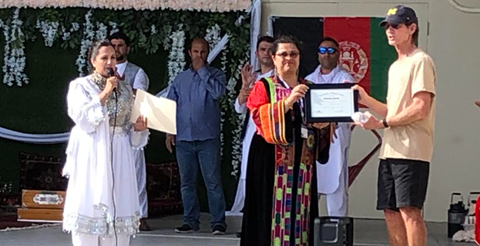 |
Judge Ahmad has finally had an interview with USCIS to get his status changed to asylum. I say ‘finally’ but in reality, getting him in that door so quickly (less than 6 months) is a bit of a miracle. Asylum is for people who have a credible fear of danger if they return to their home country. Getting shot, bombed twice and having relatives abducted by Taliban is a pretty strong case in that direction. With the backlog of asylum cases, getting an answer can take literally years. With the status our Afghan families have (Humanitarian Parole or Special Immigrant Visa) they will be here illegally before ‘years’ expire. I’ve written before about how broken our system is – this is just one example. We’re hopeful Ahmad gets his status updated well ahead of his HP expiring.
Being an Asylee does not automatically mean his wife and child can come to join him. Each day – literally – I continue to have exchanges with multiple agencies about that reunification. While there are hopeful signs, every day brings danger and death to those we’ve left behind to live under Taliban rule. That includes people living both in Afghanistan – and there are thousands – and people like the judge’s wife and daughter who are in a 3rd country. I’ve shared emails sent to me in previous newsletters. Right now, the fear is that with the focus on Ukraine, the plight of Afghani’s who are stuck after our exit will be forgotten. I am told by people who are there that under Taliban, things continue to worsen. Here’s an example from an email I received last weekend – included verbatim, but with names redacted:
I thank you heartly for your replying my email . I want to state you update of our satuation shortly as below
- taliban stopted and closed completly all girls schools higher then six class today in all Afghanistan.
Taliban issued new ordinance for men orders growing beards and for women orders wear burqa "all body cover" and also women cannot come out alone from their houses with out male.
They stoped all films ,drama serials , music and women programes in all govt and private TV & radio chinnels in all the country.
'Taliban kidnaped mony media reporters, humen and civil activists, and those who worked with foreigners these days.
Taliban humilliate people and bit by lashes in bazars commenly specialy women.
I once again thank you so much for your reply and informations you give.
As I have worked in USAID funded project I think I am eligible for SIV programme according to SIV rules. I believe that your role is important in our visa process. So I hope your involvement and contact to imigration office will cause to issue my visa even if all my family visa is not possible soon I hope they give me visa only to me. After I arive USA I will work for my family visas slowly.
I thank you so much for your pleasent of sending me visa process of Brazil . I sent an email but unfortunatly that process was suspanded now.
Thank you for your help.
Many women are now widows. That means they are relegated to being inside their home unless they have a young male child to accompany them out on the street. That means starvation. There is no schooling beyond grade 6 for girls. All women must now be in full cover (Burka) if they leave their home. Humiliation in public continues to escalate. These photos were included in emails I received:
The overlords watch on as judge and jury -
And this is the response applicants are getting from embassies they’re contacting trying to get to safety. This is from the Brazilian embassy in Pakistan. It’s the common response people writing from within Afghanistan receive.
That is from a person who worked in the media in Afghanistan. He is desperately trying to get out. All of that is a demonstration of system breakdown and failure. And yes, I share all of this with the U.S. State Department contacts I have developed. They know. I’m hopeful for Judge Ahmad and his wife and child. His mom and dad are among those stuck in Kabul, targets daily of Taliban.
I am completely supportive of the U.S. extending protections to Ukraine victims of the Russian invasion. But let’s not forget what we left behind in Afghanistan. Those lives are precious and are being lost every single day. You can see from the images and emails I share that that’s not conjecture.
Support for Ukraine
Included with some of the donations we’re receiving was this very touching note from “Kelly, in Tucson, Arizona.” It strikes at the heart of those of you who have brought donations into the W6 office. She writes “Dear Ukraine Citizen, USA loves you. If this gets to you, we wish you love and safety and a safe return to your home. Live Free, we pray.” I’ll be sure to pass the note along to one of the Ukrainian locals we see so they can pass it along to relatives back home.
This is the Russian journalist who photo bombed a newscast with a sign denouncing the Russian invasion of Ukraine. She was detained and fined the equivalent of $290 U.S. dollars for speaking out against the war. Under new laws Putin has had implemented, she could still face further persecution and years in prison.
Despite the threat of greater penalties, she continues to speak out. She told a French television station in a broadcast that came out of Moscow that she had been forced to resign from Channel One – the station she worked for during her protest. French president Macron offered her asylum. She refused, saying “I don’t want to leave our country. I am a patriot; my son is even more so. We don’t want to go anywhere.” I applaud her bravery.
Another example of bravery is the work many journalists are doing in Ukraine. I introduced you to Siobhan O’Grady last week. She’s the daughter in law of a WUNA resident. This link will take you to a 5-minute NPR interview she did on behalf of the Washington Post. In it Siobhan describes the bombed-out shopping mall as the worst carnage she has seen during her coverage of the invasion.
I spoke to representatives from some of the refugee resettlement agencies about what they’re hearing with respect to refugees from Ukraine ending up in Tucson. Last week Biden announced 100,000 visas for Ukrainian refugees. The short message is that there has been no meat placed on the bones of that commitment yet. We don’t know what kind of visas they’ll be, when they’ll be issued, what the criteria for issuing them will be, or where the refugees will end up in the U.S. What I know from current experience with the Afghan situation is the federal government does not ‘resettle’ refugees. They send them to a local jurisdiction, and we do the heavy lifting of housing, work, schooling, food/clothing/etc at the local level. I would expect the Ukraine group to be no different.
Sol y Luna Student Housing
The student housing tower that is immediately adjacent to the Islamic Center of Tucson (ICT) has been in the news for all the wrong reasons since the day it opened. I long ago lost track of the number of times I’ve been at the ICT doing damage control after they were hit by bottles and other debris from the balconies at Sol. You’ve very likely seen the stories. This is one Hannah Tiede ran last week on KOLD.
Troubled Tucson high-rise restricts rooftop access over dangerous behavior - KOLD
The objects that have been hurled from the rooftop and balconies is dangerous. But those aren’t the only impositions the place has posed for the city, and frankly, for their own residents. There have been hundreds of code violations, including things such as kids tearing Exit signs off the walls, debris piling up in hallways rendering them impassable, and damage to elevators so extensive that they’re often out of service. My suggestion to the city attorney was that we shut the place down as a public nuisance. A letter was sent to the property owner Nelson Partners implying that was our intention – but inviting them to the table to talk about solutions first. They accepted the invitation.
Nelson continues to take the position that they need video evidence in which they’re able to identify specific individuals who are throwing objects from balconies before they can evict. That’s simply false. I provided them with a copy of their own lease that contains this provision:
 |
Every example of tossing bottles from balconies is subject to Nelson Partners imposing the terms of that lease provision. During our meeting they said they’d shut down the party roof during the basketball tournament, and that they would “bring the hammer down” on occupants of the rooms from which objects were thrown. Also during our meeting, the city attorney offered to send along this letter, supporting and amplifying Nelson’s action.
As a sign of good faith, Nelson sent this advisory to the Sol y Luna residents.
All of that is some progress, but as of today, nobody has been evicted, Nelson has not taken any steps to proactively prevent further bottle-throwing incidents (screening in balconies, for example,) and Nelson has not installed their own video system providing surveillance of the balconies. Every one of the video clips I’ve provided them has come from the investment in their own safety the ICT members have made in a video system. So, it’s more than just the city that has been babysitting Sol y Luna.
During our call one of the Nelson attorneys read off the list of code issues that exist at the building. Some have been addressed, and some are ‘in progress.’ The list is lengthy. And another new one popped up over the past weekend – they're without hot water. The entire Nelson Partners team should be embarrassed and ashamed of having allowed their facility to fall into such disrepair – especially considering the high rents they’re receiving from students. For me and ICT the issue has reach a crescendo. More on this to come as we continue to push for a long-term solution.
UA Campus Farms
Last August M&C initiated an Historic Landmark (HL) zoning designation on the UA Agricultural Center that’s located on North Campbell. They prefer we don’t call it a farm. It has sheep, cows, barns and a silo. And they do agricultural research on the site. What we call it isn’t the issue – it's how its historic status is preserved that is at stake.
When M&C began the HL process, the red outlines show the area we asked to be designated. It’s the entire 140-acre site. Preservation of the historic assets on the farm is called out in the UA’s own General Plan.
The UA is not subject to city zoning rules as long as they’re the owner of the property and its being used for a governmental function. The research they’re doing on the property qualifies, so our HL designation would not affect anything they’re doing there now. It would kick in if the property was sold and a private sector entity proposed a non-governmental use such as housing or commercial development. With an HL designation, the existing structures would have to be preserved, and any development on adjacent areas would have to be compatible with that architecture. Here are a couple of examples of what’s there. |
|
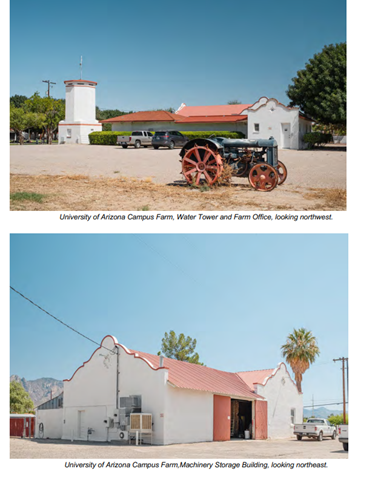 |
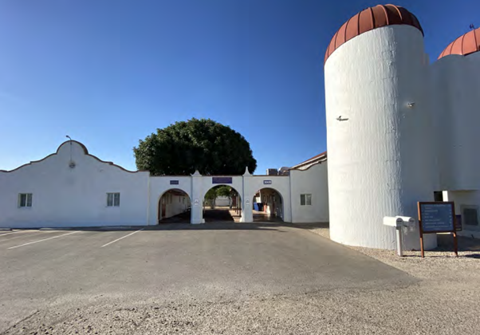 |
Many of you will remember the non-binding resolution I proposed that simply said the city believed the UA should mandate COVID testing for all students who are attending the school. We were getting infection rates north of 30% in some of the towers that are off-campus. In the week run-up to the vote on that resolution, UA president Robbins made the rounds with the other council offices and the mayor and convinced them having the city say that would be a bad look for the UA. The resolution failed 6-1. I was the one. Similarly, in the run-up to our vote on the HL, Robbins again made the rounds to some M&C offices, urging that we do not move forward with the designation. As was true with the COVID resolution, he never contacted me to talk about it. That’s very likely because he knows we have unfinished business that he doesn’t want to address.
When I asked the UA representative during our council meeting what the UA’s objection to the HL designation was, he said it might prevent them from building a “six story research center” on the property. Correct. The UA has the attitude that if it owns the property, it can build as though the surrounding area was on-campus. We saw that with the Honor’s College. We are trying to prevent it out at the farm.
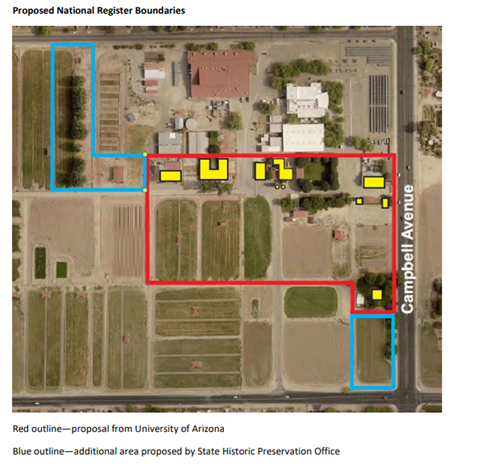
The UA proposed reducing the HL from the whole 140-acre site to what you see in red, below. The State Historic Preservation Office added the two sections outlined in blue. There might be a compromise to be found, so we agreed to continue dialogue. What we did not do was remove our intention to advance the HL to the whole 140 acres.
I run past the UA farms several times each week. There’s nothing around it that makes a 6-story research center a plausible suggestion. That’s the kind of development that belongs within the campus perimeter. More coming on this.
|
Ready, Set, Rec
Here’s my monthly note of thanks to Parks’ Sierra Boyer for pulling together the schedules for the Ready, Set, Rec vans in each ward. Here’s the Ward 6 van schedule for the month of April.

In addition to the RSR vans, the folks at Parks are hosting a city-wide virtual egg hunt during the week of March 31st through April 7th. What you do is go to any city park and look for egg shaped yard signs. You can either take a picture of the sign or scan the QR code you’ll find on it. That enters you for a chance to win prizes. Leave the sign for others to find.
Mansfield Park is located at 2000 N. 4th Ave. On Saturday, April 9th from 10am until 1pm parks will host the finale of the egg hunt contest. They’ll also have games, more egg hunts and there’s a rumor the Easter bunny will make an appearance. We’re grateful to our parks staff for being a fun outlet in the midst of some tough issues that take up so much of our mental and emotional space.
|
Tax Assistance from United Way
The deadline to file your income tax is April 18th. The United Way is offering free tax assistance for households with an income of $73K, or less. You can either do this in person (with an appointment,) or online.
In person locations include the Ward 3 council office at 1510 E. Grant, Goodwill out at 1703 W. Valencia, Literacy Connects at 200 E. Yavapai, the El Pueblo Neighborhood Center at 101 W. Irvington, Interfaith Community Services at 2820 W. Ina, the Quincy Douglas Community Center at 1575 E. 36th and Pima Collect at 4355 E. Calle Aurora. To schedule an appointment, you must first go to www.UnitedWayTucson.org/VITA.
You can also connect online. The people helping are all IRS-certified tax preparers. To get the online process started go to www.getyourrefund.org/uwtsa. Each year we’re grateful to Tony Penn and his staff for putting together this valuable tool.
Rainwater Harvesting Ordinance – Hire 3 People ID’d in City Manager Memo
Last week we gave direction to city staff to include in our ‘23 budget space for 3 new positions, each focused on the implementation of, and oversight of our commercial rainwater harvesting ordinance. The reality is that ordinance has not been effectively administered since the day it was adopted back in 2010. The reason – as was made clear in the city manager’s memo – has been a lack of staff with the focus and skill set. Our vote began the process of fixing that.
Under the ordinance, new commercial development is required to meet at least half of its landscape water needs with on-site sources. Those can be active or passive rainwater systems. Each case requires plan reviewers who are schooled in the ordinance and the various types of rainwater retention systems, and it requires staff who can go into the field to make sure sites are being developed according to plan, and that they’re maintained from year to year.
In order to properly administer the ordinance, we approved hiring 1 Licensed Landscape Architect and 2 rainwater harvesting construction inspectors. If we find those new staffers aren’t sufficient to keep up with the oversight, we might need to go back and do more later. For now, it’s a start. It’s late, but it’s a start.
RTA
During our special meeting on February 1st, we made a couple of decisions. One was to place Proposition 411 on the May 17th ballot. That’s the ½ cent sales tax extension that’ll be earmarked 80% for residential roadway repair and 20% for roadway safety elements. For a full description of that Proposition go to https://www.tucsonaz.gov/Prop411
Also during that special meeting, we voted to stay at the table with the RTA Board and try to hammer out terms for RTA Next. That’s the current ½ cent sales tax that is paying for new construction of arterials, plus transit, safety and some environmental elements. It’s due to expire in 2026.
There were a few key issues we had raised that without them being addressed many of us on the M&C had signaled that we couldn’t support the city’s participation in the next round of RTA. Those included a guarantee of fully funding the remaining City RTA projects, addressing through representation on RTA the city’s majority role in tax base and regional population, and demonstrating flexibility in scope and design to address both costs and need. During a vote the RTA had taken a couple of days before our vote they seemed to have addressed those issues. Now that’s not so clear.
With regard to fully funding our remaining projects, their motion said, “Identifying the proposed plan and funding to complete the projects as part of the original RTA.” However, in the material M&C received for our last study session, the RTA portion wasn’t so definite on fully funding our projects. For example, this is a frame I pulled from their own internal presentation, noting the highlighted portion. There’s no mention of inflation-based cost increases – an issue I’ve been raising for months.
In a memo put out to RTA Board members in early March, RTA Deputy Director Jim DeGrood included this statement (highlighted portion, in particular.)
The full RTA Board has never voted to give a subcommittee of the Technical Management Committee “authority to consider which projects should shift into RTA Next as well as evaluate any proposed scope/cost changes.” In their own material the RTA identifies the TMC as the body to take ‘recommendations’ to the full RTA Board (see my highlighted section below.)
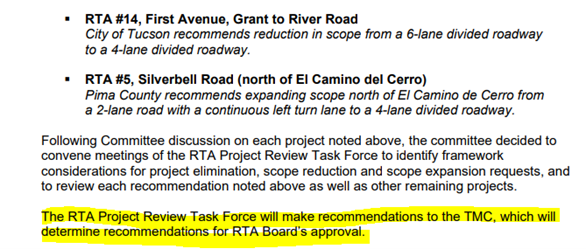 Changing policy by memo is one of the criticisms I’ve raised against the current RTA Executive Director. This is an example – and it’s an example of shifting away from their commitment to fully fund our projects and leave that decision to a subcommittee that was never given that authority by the full RTA Board.
Also note on that last slide is RTA #14 – First Avenue, Grant to River Road. That’s the portion we have made the case to reduce the ballot measure from 6 lanes to 4 lanes – reflecting actual traffic counts and saving money. Flexibility was built into the motion the RTA passed for Next. If they’re insisting on rigidity now, and not fully funding the original scope of the work on 1st Avenue, that’s going to be an issue M&C will have to consider.
As for representation – they added members from the city on what’s called the Citizen Advisory Committee. But in their motion, they also committed to adding 2 city members to what’s called the Citizen Accountability on Regional Transportation (CART) committee. The language of their motion says, “Consider increasing the number of jurisdictional appointments to the CART committee by 2 for the COT – prior to approval of RTA Next.” Now we hear that will only happen if RTA Next passes. That matters because the CART committee makes decisions related to funding and scope for current projects.
These were what I’d call linchpin issues for us before we voted to stay at the table and keep working with the RTA. They still are for me. Now that they’ve passed a motion committing to certain things, we’ve got a ring side seat to watch and see if they carry through.
COVID Update
With things now reopening what’s left to do is keep an eye on the BA.2 subvariant and see how it impacts COVID infection numbers. In New York, Connecticut and Arkansas the BA.2 has caused COVID cases to increase by more than 20% in each region. It now accounts for about 25% of all cases – but that’s a percentage of a significantly decreasing case count. BA.2 is more highly transmissable than Omicron, but with vaccines and so many people having some built-in immunity from having caught COVID, the spread of the virus is dropping overall.
Two weeks ago in Arizona we had over 5,100 COVID cases and 457 deaths from the virus. Last week those numbers dropped to 4,566 and 336 fatalities. In Pima County we had just below 500 new cases, so it’s all headed in the right direction. Our Pima County positivity rate was still at 10%. I never want to diminish the fatalities of our Pima County residents. Last week we lost 29 loved ones due to COVID. Here’s the county by county case map for Arizona.
Over 1.2M cases in Maricopa County, and over a quarter of a million cases in Pima County. That’s what we’ve been through together since March 2020. You can and should still get tested if you have symptoms, or if you’ve been around someone who tested positive for COVID. These are the Pima County health testing sites that’ll be open this week – you need to make an appointment at each site.
The flu is beginning to spread in Texas and some of the surrounding states. In Arizona we’re still doing very well though.
Harvard Global Health Institute
The Harvard Global Health Institute risk level map continues to improve. There are still some hot spots scattered throughout the nation, but this is nothing like when I was putting maps in the newsletter that were red from end to end.
Our Pima County counts are below 10 cases per 100,000 and below 100 on a 7-day average for the first time in months.
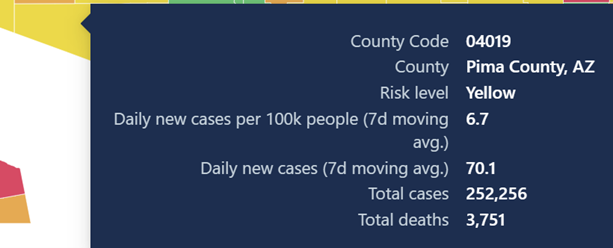
That’s all-good news to end this newsletter with.
|